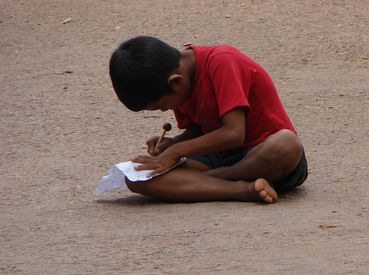
| Go to
web site main page, learning resources index. |
Content Created: 2017-05-17. File last modified: |

“History” is sometimes defined as beginning when writing does. Life before writing was “prehistoric”; societies without writing are “primitive” or, more politely, “non-literate.” And so on. But as we noted at the beginning, most humans through most of the human career have been illiterate. And there are few societies on earth, even today, in which all people are usefully literate, and not all writing systems are equally accessible.
The common expression “literate society” is therefore inherently misleading. The role of writing systems in societies varies dramatically. Especially in historical perspective, almost no society is “literate” in the same sense that any other society is.
Writing can vary in quantity. Some writers call an early society “literate” if somebody somewhere scratched a glyph on a stone, even if it remains undeciphered. Obviously that is a different literacy from what one sees in, say, modern Finland, where pretty much everybody can read and write with ease. There is, in other words, a continuous gradation between the literacy of a tiny group within a society and near universal literacy, and that gradation is not captured by simply saying that a society is “literate.”
Writing can vary in function. Using writing only for carving a few stones to mark a tomb or to glorify a king or only for covering a parchment with a table of eclipses, or only for scribbling magic spells or only for noting commercial transactions is simply not the same as using writing to create novels and legal codes and newspapers and Email.
Writing can vary in mastery. And finally there are gradations in the extent to which “literate people” in fact master a writing system or bother to use it even if they can. After all, if you don’t actually read, it doesn’t make much difference whether or not you can read, just as your English teachers have always said.
These considerations interact: If writing is awkward, why bother? If all that is around to read is tombstones, why would one care?
Acknowledging the above caveats, the appearance of texts in human history really does mark a serious turning point. For one thing, as Sequoyah observed, texts speak across time and space to people who are absent when and/or where the texts are created. And for another thing writing can store knowledge that may not be in anyone’s head. Hence texts have permited (and encouraged) a number of important cultural phenomena. It is not hard to make a list. Here is mine, with some examples. Feel free to work up your own.
1. History, including: (A) chronologies, such as Confucius’ history of his home state of Lǔ, (B) spin doctoring, such as Caesar’s report to the Roman Senate to say that conquering Gaul made excellent sense and that he was brilliant in doing it, even though it was technically illegal, (C) genealogies, such as the line of descent of a royal house explaining why the ruler is entitled to rule, (D) news, such as the fact that we are at war or the king has died or that we have had a lot of rain this year.
2. Accounts of other places and peoples, such as Marco Polo’s popular account of his trip to China or a tour guide of Vancouver.
3. Knowledge accumulation (data storage) beyond what one person can remember, including: (A) short-term notation while performing calculations, (B) efficient bookkeeping, catalogs, and inventories, (C) tables of eclipses or other calendrical or sidereal information, sometimes of religious relevance, (D) big data, (E) census for purposes of collecting taxes or drafting armies. (Career bureaucrats in traditional China sometimes hid the census records for a district from a newly appointed magistrate to make him dependent upon them to collect taxes for him.)
4. Instruction, including: (A) elementary textbooks, (B) religious scriptures and moral tracts, (C) complex instructions (such as recipes, medical prescriptions, or machine assembly instructions)
5. Contracts, especially any agreement without which some people otherwise could find it in their interest to have different memories later, including: (A) labor, trade, or marriage agreements, (B) wills, loans, gifts, (C) oaths of loyalty (including loyalty to criminal gangs).
6. Art, including all aspects of writing, from poetry to novels to calligraphy. (In general, anything that is within our conscious control can be done with or without the grace, skill, originality, appropriateness, and other qualities that constitute art, so writing as art is not surprising. Even making gross noises with your armpits can be done with greater or less artfulness. If in doubt, ask your suitemates to demonstrate.)
7. Data leaks. (You can never be sure who will read a text. Just as Caesar didn’t compose the Gallic War for us, but we read it anyhow; you probably don’t intend your Facebook page for the contemplation of a potential employer, although potential employers routinely look at them. And, like Caesar, you certainly don’t expect it to be read two thousand years from now.)
Losers. Not everybody loves texts. “A big book is a great evil” (Μέγα βιβλίον μέγα κακόν), wrote the philosopher Callimachus (Καλλίμαχος) of Libya (310-240 BC), and it became his most famous aphorism, especially among students. Callimachus aside, many of the advantages of writing in the list above have consequences that disadvantage someone.
And so on. On the whole, not being able to fudge earlier events and intentions would seem to be a good thing, even if that is not always the case, and obviously there are losers as well as winners. (Click here for more detailed downside examples.)
Perhaps one of the biggest “issues” with literacy is its role in defining elites, to which we briefly turn now.In some societies the use of literacy is a key means of social differentiation, with the elevation of people who can and do use writing (often wealthy men) over illiterates (typically women, children, the poor, the uninitiated, &c., depending upon the period and place). Especially when literacy is not easily mastered, only some people have the talent, leisure, or ambition to bother with it. Looking cross-culturally, we see several patterns:
Craft literacy. The term “craft literacy” has been coined to describe the literacy of a society in which the ability to use written language is a “craft,” limited in distribution to specialists. These may be a priesthood (as in Egypt) or a closed occupational category of scribes (as in Mesopotamia). Often —not always— there are deliberate attempts to keep literacy exotic, sometimes defended by its connection with a magical or religious use of writing, but inevitably connected with a political or economic monopoly by the literate. In early Egypt, for example, writing was a priestly monopoly, or at least the priesthood tried to keep it that way. (Even today certain documents may demand the specialized knowledge of professionals, such as programmers, publicists, or lawyers.) In Mesopotamia or in Classical Greek and Rome, in contrast, being a professional scribe was simply a job, and sometimes scribes were even slaves.

Elite Literacy. The term “craft literacy” goes somewhat past its range of convenience if it is generalized to cases in which literacy is generally extended to all upper-class males, as in classical India, Israel, Rome, or China, since the ability to use writing does not then constitute a craft as such. However, the issue of whom literacy includes or excludes obviously remains relevant. Sometimes the intricacies either of the writing system itself or, more often, of written style and stylistic flourishes become enormously complex, so that it can take years to master the art of writing “properly.” In that context, literary skill becomes a badge of elite status, and elites may even seek to deny the necessary education to “inappropriate” learners (such as women or slaves or farmers).
Leakiness. Unless the script is so clumsy as to be virtually useless for ordinary purposes (as Maya script was), knowledge of writing, or anyway the idea of writing, tends to leak out to the more general society, usually with some degree of simplification.
One of the most famous and compelling examples of simplified script leaking out for use among those denied “standard” literacy is the Japanese literary masterpiece, Tale of Genji (Genji Monogatari 源氏物語), written entirely in syllabary. The author, known by the pseudonym of Murasaki Shikibu (紫式部), “Lady Murasaki,” (ca 978-1031) was a court lady, but she wrote exclusively in the low-prestige hiragana syllabary because Japanese women were not supposed to learn standard, higher prestige Sino-Japanese script, the one full of borrowed Chinese characters. (The Japanese title should probably really be printed in syllabary form —げんじものがたり— not the Chinese-character form 源氏物語.) It is an irony lost on no one that the most famous work of Japanese literature was not composed using its most prestigious writing variant because the writer was female.
But usually the greatest variation across social classes is written style. In general, one can glimpse a tendency for evolution in two directions. One is toward high style, dependent upon broad education and reading and full of elegant flourishes, uncommon vocabulary, and allusions to prior literature. High style is used and enjoyed by elites for various reasons, but its effect, conscious or not, is to tag their own social superiority. The second evolution is toward low style, a more vulgate simplification used for rough-and-tumble, low-prestige, everyday needs of the less educated, like posting (misspelled) signs, making (abbreviated) grocery lists, or sending (slightly garbled) text messages.
In a few cases political revolutions have resulted in attacks on inaccessibly refined “high” styles as a way of breaking the upper-class stranghold on literacy. The most famous cases are Turkey (after the 1918 revolution), which sought to purge the language of Arabic and Persian loan words in favor of a purely Turkish vocabulary and syntax, and China (after the 1911 revolution) which sought to make written syntax follow spoken language. (A later, less radical reform in China simplified and sometimes consolidated the written characters in hopes of facilitating learning.)
In other cases, such as occasional spelling reforms in Europe, small adjustments have been made in the interest of consistency, or of recognizing overwhelming popular usage (adjustments that the French Academy refers to as tolerances). English, despite occasional unsuccessful private efforts, seems particularly ripe for fairly drastic reform, as (the students of) any college writing instructor can attest. (Like, dude, U otto be able to rite like U talk. Click here for a crotchety rant.)
Despite facile generalizations and widespread misunderstandings about language and writing, it is broadly true that the invention of writing forever changed human life.Return to top.
Go to next page.